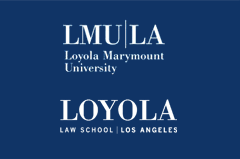Policies
Contents
- Philosophy of Journal of Clinical Art Therapy
- Who Can Submit?
- General Submission Rules
- Tips and Clarification
- Submission Preparation Checklist
- Formatting Requirements
- Rights for Authors and Loyola Marymount University
- Attribution and Usage Policies
- General Terms and Conditions of Use
- Submit an Article
Philosophy of Journal of Clinical Art Therapy
For more information, please see Journal of Clinical Art Therapy Aims and Scope page.
Who Can Submit?
Anyone may submit an original article to be considered for publication in Journal of Clinical Art Therapy provided he or she owns the copyright to the work being submitted or is authorized by the copyright owner or owners to submit the article. Authors are the initial owners of the copyrights to their works (an exception in the non-academic world to this might exist if the authors have, as a condition of employment, agreed to transfer copyright to their employer).
General Submission Rules
Submitted articles cannot have been previously published, nor be forthcoming in an archival journal or book (print or electronic). Please note: "publication" in a working-paper series does not constitute prior publication. In addition, by submitting material to Journal of Clinical Art Therapy, the author is stipulating that the material is not currently under review at another journal (electronic or print) and that he or she will not submit the material to another journal (electronic or print) until the completion of the editorial decision process at Journal of Clinical Art Therapy. If you have concerns about the submission terms for Journal of Clinical Art Therapy, please contact the editors.
Tips and Clarifications
- If you have a paper you would like to see published, first consider whether it is appropriate for the Journal of Clinical Art Therapy. The journal's Aim and Scope and Policies sections provide information on what kinds of manuscripts are in its scope and purposes.
- We highly suggest that before submission, ask trusted colleagues to read your manuscript to spot obvious errors in data, make sure that your thesis is clear and supported by your findings, and is written for a professional audience. Use your colleague's feedback to refine the paper and make corrections.
- Review the information available regarding this journal and check that your manuscript is in order before submission. Specifically use the preparation checklist under “policies” as an indicator whether you are ready to submit your paper. Common problems that result in an immediate return without review are a) failure to conform to APA style in reference citations and manuscript preparation, b) excessive length, c) excessive number of figures or tables, d) missing abstract, e) author's name appears in the body of the text, and f) manuscript does not conform to submission categories.
- To submit the manuscript click the “submit an article” button, log in with a username and password, and follow the instructions to upload your file and provide essential information. You will receive an automatic email message acknowledging that your manuscript was received.
- It will take about four weeks for your manuscript to be reviewed, depending upon the volume of submissions waiting for review. To ensure impartiality, the editor will assure that you removed your name from the manuscript and send it to two or three reviewers. It is important to understand that the review process takes time as most editors and reviewers are working professionals who volunteer time to the journal while juggling many other duties. When the reviews are not in agreement, your manuscript may be sent to an additional reviewer and this also adds to the time the review process.
- The reviewers will evaluate according the criteria of 1) appropriateness for the journal, 2) adherence to APA requirements, 3) quality of the writing, 4) quality of the content, and 5) significance to the field of Art Therapy. They assess its overall strengths and weaknesses, assign a numeric evaluation for each of these categories, and may make suggestions for improvement.
- Finally, an editorial decision will be made based on reviewer recommendations. You will receive a letter stating either a) that Journal of clinical Art therapy will publish the paper, with or without revisions prior to publication, b) revisions are necessary before considering it for publication, or c) why the paper cannot be published.
- You may be informed that while the paper cannot be accepted as is, the reviewers agree to review it again as a revision. It is important to follow their suggestions closely, keeping in mind that their opinions are informed by publication experience. Although not a guarantee of future acceptance, the recommendation to revise usually comes from the reviewers' desire to support the manuscript's potential for publication. Revise and resubmit the manuscript, following the same steps, and include a cover letter stating how you addressed the reviewers' evaluative feedback.
- If your paper is accepted for publication, you may be asked to make some minor revisions and submit the paper one last time along with a high resolution CD version of any images.
- Please make sure that you obtain all relevant consents and releases to use artwork or clinical cases, or participant’s responses for publication. It is your responsibility to have informed consents and releases obtained before publishing your work in the Journal of Clinical Art Therapy. Nevertheless, the editors reserve the right to ask for a copy of these documents at anytime.
Formatting Requirements
Journal of Clinical Art Therapy has no general rules about the formatting of articles upon initial submission. There are, however, rules governing the formatting of the final submission. See Final Manuscript Preparation Guidelines for details. Although bepress can provide limited technical support, it is ultimately the responsibility of the author to produce an electronic version of the article as a high-quality PDF (Adobe's Portable Document Format) file, or a Microsoft Word, WordPerfect or RTF file that can be converted to a PDF file.
It is understood that the current state of technology of Adobe's Portable Document Format (PDF) is such that there are no, and can be no, guarantees that documents in PDF will work perfectly with all possible hardware and software configurations that readers may have.
Submission Preparation Checklist
Before submitting your manuscript, please make sure your have prepared the manuscript to according to the criteria below:
- The paper is an original submission not previously published or under consideration of another publication.
- The paper is well organized, does not exceed 5,500 word limits, and is written in good English.
- It meets the publication standards of the APA Publication Manual (6th ed.). Please see www.apastyle.org or http://owl.english.purdue.edu/owl/resource/560/01/ for online help)
- It contains keywords and a 120 word abstract. Author's name, address, position, or affiliations do not appear on the cover sheet or anywhere in the text (to facilitate blind review).
- Manuscript is saved with a file name that describes title of article but does not disclose the author's name or place of work. Submission file should be in Microsoft Word format.
- Notes, structure, and writing style are typed as normal text in APA style. References are error-free and completed in APA style (6th edition)
- Tables, Figures, and Appendices are embedded in the manuscript. No more than 8 figures and tables are included. Figures are scanned at high resolution (300 dpi) and saved in jpeg, tiff, gif or excel formats.
- Permission to reproduce all artwork, consents to participate in research and releases for publications from clients and relevant agencies, have been secured from the copyright holder; client confidentiality has been maintained and proper releases for client artwork has been obtained.
Rights for Authors and Loyola Marymount University
As further described in our submission agreement (the Submission Agreement), in consideration for publication of the article, the authors assign to Loyola Marymount University the right of first publication and non-exclusive right to make the work available in any format in perpetuity. Authors retain copyright, but Loyola Marymount University requests that the work be simultaneously licensed under a Creative Commons Attribution License that allows others to share the work with an acknowledgement of the work’s authorship and publication in this Journal.
Attribution and Usage Policies
Reproduction, posting, transmission or other distribution or use of the article or any material therein, in any medium, requires acknowledgement of the work’s publication in this Journal.
General Terms and Conditions of Use
Users of the Loyola Marymount University repository website and/or software agree not to misuse this Loyola Marymount University service or software in any way.
The failure of Loyola Marymount University to exercise or enforce any right or provision in the policies or the Submission Agreement does not constitute a waiver of such right or provision. If any term of the Submission Agreement or these policies is found to be invalid, the parties nevertheless agree that the court should endeavor to give effect to the parties' intentions as reflected in the provision, and the other provisions of the Submission Agreement and these policies remain in full force and effect. These policies and the Submission Agreement constitute the entire agreement between Loyola Marymount University and the Author(s) regarding submission of the Article.
Submit an Article
To Submit an article to Journal of Clinical Art Therapy, please click here.

